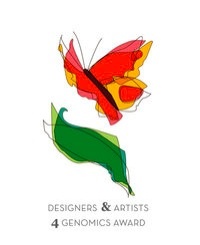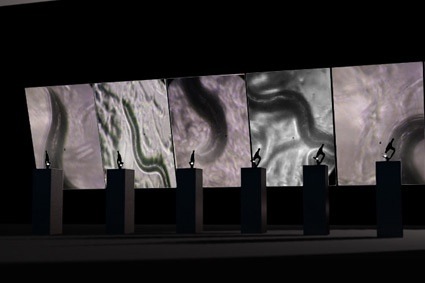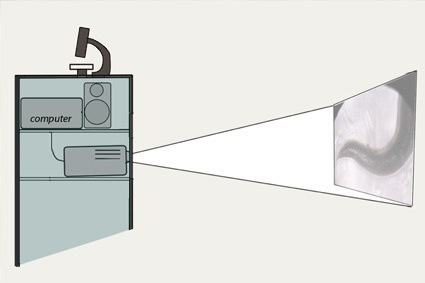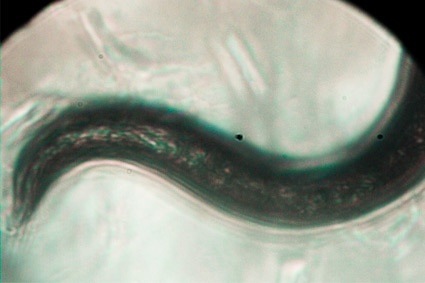 A few months ago, the Waag Society in Amsterdam teamed up with the Netherlands Genomics Initiative and the Centre for Society and Genomics to launch the Designers & Artists 4 Genomics Award which invited emerging artists and designers to submit projects involving the exploration of Life Sciences. The works selected were to be developed together with the country’s most prestigious genomics centres.
A few months ago, the Waag Society in Amsterdam teamed up with the Netherlands Genomics Initiative and the Centre for Society and Genomics to launch the Designers & Artists 4 Genomics Award which invited emerging artists and designers to submit projects involving the exploration of Life Sciences. The works selected were to be developed together with the country’s most prestigious genomics centres.
You might have heard of similar initiatives in the USA or in the UK but mainland Europe doesn’t have such a strong tradition of setting up collaboration between research centers and artists/designers. Hopefully, the DA4GA award will pave the way for more partnerships of the kind both in The Netherlands and in the rest of Europe.
The winning projects were revealed last month: a bullet proof skin, an ecological bioreactor and an opera performed by mutated worms. The winning proposals will be exhibited from mid-June until the end of December 2011 but the curious blogger in me wanted to have a sneak peak of the 3 projects before they go on show. In the coming days i’m going to dedicate several posts on the winning works as well as on the award itself. And i’m opening the series with the Microscopic Opera!
Matthijs Munnik is going to collaborate with Netherlands Consortium for Systems Biology on an audiovisual installation in which tiny, transparent mutated lab worms are producing sounds and images.
 3D impression of the final installation
3D impression of the final installation
Hi Matthijs! I had a look at your portfolio and unless i missed something it seems that you haven’t worked much with genetics so far. Did you find it difficult to get to grips with this rather techy field? How much of a challenge was it to approach genetics as a visual artist?
No, I didn’t have any experience in this field. When I started working on this project I read Denis Noble’s book The Music of Life, which I can recommend to anyone, to become a little bit more familiar with systems biology and genetics. For me as well as for the scientist from NCSB brainstorming on this project together was very interesting. I thought it would be a lot more difficult, but it turned out to work great.
 Can you give us more details about what you hope to realize with this project?
Can you give us more details about what you hope to realize with this project?
In my project I’m using common research tools, but instead of using them for scientific research I use them to create an art piece.
The organisms I use in the installation are C. elegans, used extensively in scientific research, for a wide array of purposes. Often this research involves C. elegans that have been given a mutation that is not visible under the microscope. As a handy tool, researchers give these worms an extra mutation that makes them move in a different way; they are twitching, or moving like a corkscrew, or they become really obese. In my installation I use these handicapped mutants, and translate their movement into sound. The worms are projected in real time on screens behind them. I want to control the movement of the worms to a certain degree with temperature and vibration, to create a composition based on an opera. I’m working on making the worms control a synthesized opera voice, and I try to use the same image analysis algorithms researchers at NCSB use.
With this project I try to research the artistic value of some research tools, and shine a new light on them. On the other hand I’m also fascinated by the worms, who have no idea of the world above them. We are like gods to these little lab worms, following them from their first cell division to their death, manipulating their bodies and mutating their DNA. Are we really like gods, or are we like the worms, unaware of the things above us in a different dimension, the biggest thing becoming the tiniest.
How did you get interested in this humble worm?
C. elegans has been used extensively as a model organism and a researcher introduced me to them. Not only does it move in an elegant way, like its name suggests, it’s also the first multicellular organism to have its genome completely sequenced. Besides these nice aspects they are also easy to keep and you can even train them to some extent.
 The results of the competition have been announced last month. Have you already started to work on Microscopic Opera? How is the collaboration with Netherlands Consortium for Systems Biology taking shape? Are they mostly your consultant when you need some feedback about the most scientific details or do you have a more symbiotic relationship with them? Do you work at their venue for example?
The results of the competition have been announced last month. Have you already started to work on Microscopic Opera? How is the collaboration with Netherlands Consortium for Systems Biology taking shape? Are they mostly your consultant when you need some feedback about the most scientific details or do you have a more symbiotic relationship with them? Do you work at their venue for example?
Yes I’ve started expermenting with the worms and doing some programming. I’ve also done a lot of discussing with the NCSB team, mostly consulting me on technical issues, but I’ll also be working some more in their lab, which I’m very looking forward to.
Thanks Matthijs!
All images courtesy Matthijs Munnik.
